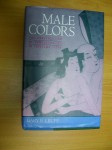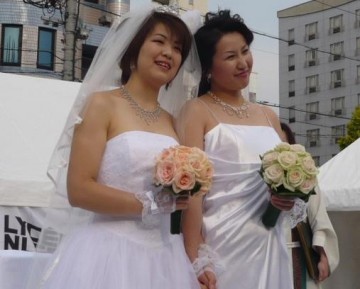06 June 2007
Japan's crazily advanced gay movement
Can you believe this is happening in our country? Most conservative among advanced nations.
The couple is not just lesbians that you can normally see in SOHO in NY or Castro Street in San Francisco.
A woman on the left is Ms. Kanako Otsuji, former member of Osaka prefectural assembly. Now she is running in upcoming nationwide election campaign as candidate for the second largest political party, Democratic Party of Japan.
She came out as lesbian two years ago while she was a member of the assembly.
On this wedding she received the congratulatory message from the party leader, Ichiro Ozawa, known as conservative type of politician. Wow, what is happening in Japan?
Well, as I wrote on this blog, our society used to be very open-minded to gays. We were very free sex nation.
But since westerners came in late 19th century, our view of sexuality has drastically changed.
We may be moving backward.
21:25 Posted in Japan News | Permalink | Comments (0) | Tags: gay, lesbian, Japan, homosexuality
31 May 2007
Suicidal Society, Japan
This week has been suicidal week for Japan. On Monday, minister of Agriculture and Fishery, Toshikatsu Matsuoka committed suicide by hanging himself in the Diet members' residential building. He left several suicide notes including one to the whole nation. He was amid so many scandals. On the same day, famous singer, ZARD stepped down from the stair of the hospital, where she was hospitalized for her cancer cure. She did not leave any suicide note but it was speculated that she may have committed suicide. Next day, an old man who was the head of the organization linked to the minister's scandal jumped off the building.
Then on Wednesday, a high school girl hanged herself in her school. Everyday around 100 people committed suicide. It is estimated 1,000 attempted to kill themselves. Japan's suicide probability rate is double that of the U.S.
Why, so many?
We had the tradition that valued suicide act like harakiri of Samurai. It had been considered honorable.
We live in the society that an individual cannot speak out inner-self. It is called "Culture of shame."
We are living in kind of depressed society.
The theme to live in Japanese society is how to survive in such depressed and stressful environment.
21:00 Posted in Japan News, Society | Permalink | Comments (0) | Tags: suicide, Japan
24 May 2007
TV Mini-Series "Shogun" God Cursed Sodomite!
I rent DVD of TV Mini Series "Shogun" aired in U.S., 1980. I remember when I first visited the U.S., American host family where I stayed played the video of this show to welcome me. It was a very popular show. So I just wanted to see it again.
The story takes place late 16th century in Japan, when Japan was not unified. An English shipper captain, John Blackthorne was saved by the Samurai Lord, Toranaga after his ship was wrecked by the heavy storm. Blackthorne then learned how to become Samurai. Later Toranaga became the shogun, the general who governs whole of Japan. Toranaga is actually named after Tokugawa Ieyasu, who founded Tokugawa dynasty that continued for 2 and half century just by his descendants.
It was almost 10 hour show. I enjoyed only first 2 hours. As for rest of the show, I fast forwarded just to see how Japan was depicted. More than half of the show was spoken in Japanese. I could not understand how American viewers could enjoy it although each Japanese conversation was interpreted by Japanese care taker woman for Blackthorne. Kind of frustrating to see for the English viewers, I wondered. But there are many new and exciting things introduced in the show especially for westerners such as Harakiri, a man and a woman taking bath together. Not common in modern Japan but typical and normal in that era.
There was a very interesting thing even for Japanese. That proves that sometimes foreigners know better of our country's history. In the scene, Japanese care taker woman named Mariko told Blackthorne that he should choose a woman to sleep with for his health. Blackthorne declined. Then Mariko said "Do you prefer a boy?"
He was so shocked and got angry and then said "I am not God Cursed Sodomite! My intimate customs doesn't include boys." I was surprised, too. But the truth is in that era, Sodomite was considered normal in Japan.
If you want to know more about that, please read this post.
21:00 Posted in Film | Permalink | Comments (0) | Tags: japan, samurai, gay, homosexuality, tv
12 May 2007
Learning Japan's hidden history by American scholar
Male Colors: The construction of homosexuality in Tokugawa Japan
by Gary P. Leupp, Professor of Japanese History at Tufts University, USA,
I happenned to buy this book almost ten years ago in America.

Before reading this book, I had thought it unlikely that there was any homosexuality in Japan . I also took a negative view of homosexuality, seeing it as a result of the decadence of Western culture. When I came across this book, while in the USA , I was therefore astonished to learn about an aspect of Japanese history about which I, a Japanese, knew nothing.
The book is primarily concerned with male homosexuality in Japan during the Edo Era. However, the Introduction also mentions nanshoku (literally, “male colors”), as the practices of homosexuality and pederasty were then known, as it was prevalent at earlier times. It is said that Kūkai a monk who introduced Buddhism to Japan from China brought the practice of nanshoku, and it was at first mainly among monks that the practice spread. However, during the Age of Warring States (16th century), nanshoku became extremely common among men of the samurai caste. Historical records show that famous samurai lords such as Oda Nobunaga and Takeda Shingen, for example, had sexual relations with their retainers, and there still exist documents showing that Takeda Shingen and his vassal Kosaka Masanobu wrote pledges of sexual love to each other.
After the years of war and chaos, the Edo Era (1603-1867) began with the Tokugawa Shogunate establishing its rule over Japan . However, the Nanshoku Culture continued, and records show that 7 of the 15 Tokugawa shoguns engaged in homosexual activities. Homosexuality was not restricted to the samurai, but was prevalent among the ordinary townsfolk as well. At that time, nanshoku was classified as two main types. In the first type, a couple of men with a marked age difference were seen as having a relationship modeled after older and younger brothers. The second type, on the other hand, was influenced by the male-chauvinist perspective of contempt for women, and one partner took the female role, enabling two men to imitate a heterosexual relationship without having to lower themselves to sexual contact with impure females.
Ihara Saikaku famous novelist in that era, wrote Kōshoku Ichidai Otoko (The Life of an Amorous Man) which is representative of the practice of nanshoku among the common people. The principal character, Yonosuke, the son of a rich merchant, has sexual intercourse with 3,275 women and 725 men during the course of his life. That is a ratio of 5:1, but it probably reflects the general male sexual orientation at the time. To summarize, homosexuality was not a minority concern in society during that era, and the typical male sexual orientation was what would now be termed “bisexual”.
The above information raises the question of why Japan changed so drastically to a society in which homosexuality is regarded with loathing. Leupp indicates the process of modernization during and after late 19th century known as Meiji Era as the cause of this. After Japan opened up to the rest of the world, many Westerners visited Japan and transmitted aspects of Western culture, one of which was severe criticism of the Japanese nanshoku Culture. The ruling and influential classes at that time had great concern about such hostility, and started to insist that nanshoku was morally wrong, in order to bring Japan into line with the Western system of values.
However, a great change can now be seen to have taken place in Western society. In Europe, the USA, and some other countries, the Gay Liberation Movement has been successful in recent years, and in some European countries and some US states even homosexual marriage is now accepted. In other words, Westerners, who introduced loathing of homosexuality to Japan , as part of “modern culture”, have now reconsidered their own value systems. These are certainly curious times in which we live!
Leupp also points out that, in terms of the main currents of society, nanshoku in pre-modern Japan offers a good historic example for discussion about homosexuality. Homosexuals are now generally considered to be a minority of the population, making up 2% to 5%, or perhaps 10%, of the total. However, at least with respect to Japan during the Edo Era, it is difficult to see this as being the case. At that time, Japanese men seem generally to have been bisexual. To conclude, this book suggests that human sexuality is neither innate nor created by a particular family environment, but is a product of the wider society.
It is not just a history of Japan but whole humanity, isn't it?
22:20 Posted in Books | Permalink | Comments (0) | Tags: gay, japan, homosexuality, history






